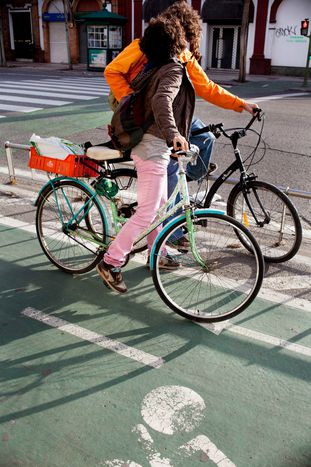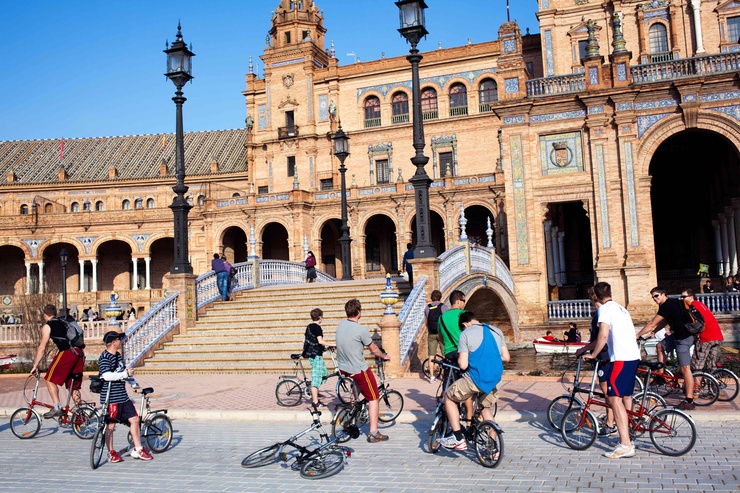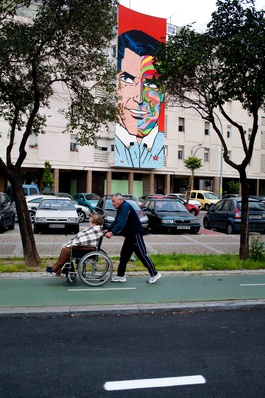
Rolling down 120km of bike lane in Seville
Published on
Translation by:
Cafebabel ENG (NS)Drivers and vehicles in the centre of Seville cannot be parked for longer than 45 minutes, but it wouldn’t bother the southern Spanish city’s cyclists
In Seville you can easily confuse bicycle bells with the tramway bells. On a sunny afternoon of many here, the two co-exist peacefully on the central Avenue de la Constitución. The bikes glisten in white and red in the colours of the Sevici, the town hall’s bike rental initative which was launched in 2004 and charges an honest 25 euros (£22) a year for membership.

Pedestrians and suburbans
 With an accomodation climate, a reduced level of pollution (or so it seems - this survey suggests the city comes second to Barcelona for pollution levels) and a flat landscape, this city encourages its 700, 000 residents to get on a bike. Add to that the fact that the local council has been pedestrianising the historical centre since 2005; trams, a new metro line and bikes have become the new cars in a city where you can’t spend more than 45 minutes on four car wheels in the city. Seville follows London, Copenhagen and even New York are examples of becoming the pedestrian cities of the new age. In 2011 it will also host the Vélo City event. The official website explains that in two years the number of bike users has gone from 6, 000 to 66, 000!
With an accomodation climate, a reduced level of pollution (or so it seems - this survey suggests the city comes second to Barcelona for pollution levels) and a flat landscape, this city encourages its 700, 000 residents to get on a bike. Add to that the fact that the local council has been pedestrianising the historical centre since 2005; trams, a new metro line and bikes have become the new cars in a city where you can’t spend more than 45 minutes on four car wheels in the city. Seville follows London, Copenhagen and even New York are examples of becoming the pedestrian cities of the new age. In 2011 it will also host the Vélo City event. The official website explains that in two years the number of bike users has gone from 6, 000 to 66, 000!
José David Muñoz de la Torre, who is in charge of the development of the bicycle routes in the city, gives us the famous spiel of how fast and economic the lanes are. However Alejandro Cuetos Menendez, a member of the ecologists in action ('Ecologistas en Accion') collective, emphasises at a cafebabel.com Seville local debate on pedestrianisation that the ‘real needs are in the suburbs.’ In cities like Paris, you are able to take the Vélib across the borders of the city and into the suburbs. In Seville there is no synergy between the city centre which is so adored by tourists and the surrounding areas where the majority of Sevillans actually live. Those in the suburbs then have no other choice than to use cars, buses or the only metro line – for which one entry is not so cheap, at 1.60 euros (£1.41) a ticket.
 ‘Sevici is 100% financed by the Seville city hall,’ explains José David Muñoz de la Torre. ‘The regional Andalusian government does not finance us. Seeing as the money comes directly from the city, so it’s up to the other Andalusian municipalities to invest in bike services themselves.’ With local elections due at the end of May in Spain, where the ruling Zapatero’s party is the grand loser, perhaps the model of this city can indeed give fellow cities and towns a similar idea.Despite the 250 bicycle posts across 300 metres, the transition didn’t take place without a few bumps in the road. ‘Bikes weren’t so welcome in the city centre,’ remembers Italian photographer Chiara, who participated in an erasmus student exchange programme in Seville a decade earlier. ‘It was very difficult so I am pleased with how much it has changes.'
‘Sevici is 100% financed by the Seville city hall,’ explains José David Muñoz de la Torre. ‘The regional Andalusian government does not finance us. Seeing as the money comes directly from the city, so it’s up to the other Andalusian municipalities to invest in bike services themselves.’ With local elections due at the end of May in Spain, where the ruling Zapatero’s party is the grand loser, perhaps the model of this city can indeed give fellow cities and towns a similar idea.Despite the 250 bicycle posts across 300 metres, the transition didn’t take place without a few bumps in the road. ‘Bikes weren’t so welcome in the city centre,’ remembers Italian photographer Chiara, who participated in an erasmus student exchange programme in Seville a decade earlier. ‘It was very difficult so I am pleased with how much it has changes.'
Local residents agree. Agustin Irissou has spent twenty-five years encouraging the use of bicycles as a method of transport like any other with the association A contramano. He explains that the Spanish right-wing under the popular party (PP) didn’t really concern themselves with the subject. ‘Sevici was born out of battles with the local municipality. We had at least four protests a year. Things have changed since then. The political authorities in Seville know well that bicycles have to be reckoned with today. Finally our message has been heard,’ he smiles.
This article is part of cafebabel.com’s 2010-2011 feature focus on Green Europe
Images courtesy of ©manutrillo/ Velo-City Sevilla 2011
Translated from Séville pédale plus pour respirer mieux



